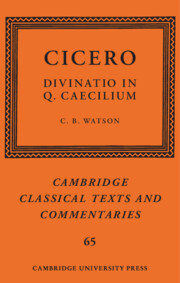
-
Select format
-
- Publisher:
- Cambridge University Press
- Publication date:
- August 2025
- September 2025
- ISBN:
- 9781108933292
- 9781108844079
- Dimensions:
- (216 x 138 mm)
- Weight & Pages:
- 0.79kg, 552 Pages
- Dimensions:
- Weight & Pages:
- Subjects:
- Ancient History, Classical Studies, Classical Literature
- Collection:
- Cambridge Classical Texts and Commentaries
- Series:
- Cambridge Classical Texts and Commentaries (66)
You may already have access via personal or institutional login- Subjects:
- Ancient History, Classical Studies, Classical Literature
- Collection:
- Cambridge Classical Texts and Commentaries
- Series:
- Cambridge Classical Texts and Commentaries (66)
Book description
This is the first scholarly commentary on Cicero's Divinatio in Caecilium and the first new critical edition in over 100 years. The commentary demonstrates that the Divinatio was atypical of the genre. In both form and content, the speech is styled as a forensic prosecution rather than a pre-trial deliberation. It also functions as an effective piece of literary criticism and a pedagogical treatise to preface the Verrine corpus. Consequently scholars are encouraged to reconsider how published oratory in Rome functioned as teaching aid, personal propaganda, historical record, and literary production. The Divinatio touches on issues with strong resonance for contemporary society: the responsibility of the government to represent and defend marginalised communities, cultural identity and integration in a multi-ethnic society, the perils of persuasive speech, abuses of political and military power, due process of law, and changing notions of intellectual and cultural property.
Contents
Metrics
Full text views
Full text views help Loading metrics...
Loading metrics...
* Views captured on Cambridge Core between #date#. This data will be updated every 24 hours.
Usage data cannot currently be displayed.
Accessibility standard: WCAG 2.1 A
Why this information is here
This section outlines the accessibility features of this content - including support for screen readers, full keyboard navigation and high-contrast display options. This may not be relevant for you.
Accessibility Information
The PDF of this book complies with version 2.1 of the Web Content Accessibility Guidelines (WCAG), covering newer accessibility requirements and improved user experiences and meets the basic (A) level of WCAG compliance, addressing essential accessibility barriers.
Content Navigation
Table of contents navigation
Allows you to navigate directly to chapters, sections, or non‐text items through a linked table of contents, reducing the need for extensive scrolling.
Index navigation
Provides an interactive index, letting you go straight to where a term or subject appears in the text without manual searching.
Reading Order and Textual Equivalents
Single logical reading order
You will encounter all content (including footnotes, captions, etc.) in a clear, sequential flow, making it easier to follow with assistive tools like screen readers.
Short alternative textual descriptions
You get concise descriptions (for images, charts, or media clips), ensuring you do not miss crucial information when visual or audio elements are not accessible.

